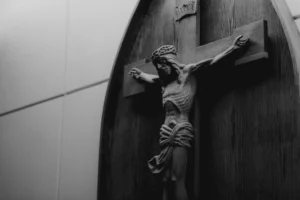The shepherds rushed through town, scouring small houses for light and listening for the cry of a newborn. Each of them remembered what the angel had said: “You will find a baby wrapped in swaddling cloths and lying in a manger” (Luke 2:12). It would be a sign, he had told them. After that, the sky had opened up and a chorus of angels, all praising God, joined him. Suddenly, it didn’t seem so strange to break the prime directive of shepherding: Never leave the sheep.
No inflatable, light-up nativity scene on the front lawn would be complete without a manger. It’s the centerpiece and focal point of the Christmas story. It’s the cradle of the Son of God, a symbol of the humility He wrapped around himself when He put on flesh and came to earth. And it was a sign for the shepherds. In a way, the sign of the manger was an invitation to the world’s very first Christmas party. But just like an invitation today that’s viewed for a moment and then discarded, it can be easy to miss the significance and beauty of the manger.
More than an improvised cradle
How many times have we heard the Christmas story and just skimmed over the part about the manger? Have we ever thought about how strange a thing it would be to actually find a baby in a manger?
Imagine visiting friends who just had a baby. You arrive at their home to meet their little bundle for the first time, and they usher you down the hallway to the nursery. But instead of finding a newborn lying in a crib or a bassinet, there he is — an 8 pound, 5 ounce baby boy, swaddled and asleep in the dog’s food bowl! If you saw something like that, you wouldn’t just gloss over it and move on. You’d have lots of questions — the same sort of questions we should be asking when our eyes light upon the mention of the manger in Luke’s gospel.
A manger is a feeding trough for farm animals — a simple, everyday, dirty feeding trough. And the shepherds were to look for the newborn Savior in one. It was to be a sign for them (Luke 2:12). But, a sign of what? I believe the manger points to the very manner in which Jesus would become their Savior.
Some 33 years after Jesus lay in that feeding trough, He took bread, broke it and told His disciples, “This is my body, which is given for you” (Luke 22:19). On Good Friday, Jesus became life-giving bread for His followers. And so it is fitting that, as He entered this world in the town of Bethlehem — which means “house of bread” — He would be placed as animal food in a manger. It’s as if, looming over the Christmas story, out on the horizon, the cross stands, its shadow stretching back over Jesus’ entire life.
But this shadow brings neither gloom nor despair. Though the cross would become a painful cup for Jesus to swallow (Luke 22:41-44), He would endure it out of love for the Father and for the joy that was set before Him (Hebrews 12:2). And it will become salvation for all who trust in Him (1 Corinthians 1:18). The shepherds may not have fully understood the sign of the manger or how exactly the baby they just met would become the Savior of the world, but they trusted that God was up to something good. Luke 2:20 tells us they returned to their fields, “glorifying and praising God for all they had heard and seen.”
Many believers proudly declare, “Jesus is the reason for the season!” But could it be that we have so focused on making sure the baby in the manger is at the center of our Christmas story celebration that we’ve missed the neon arrow pointing from the manger to the cross? Jesus’ coming to earth 2,000 years ago would have been nothing more than a lovely divine visit if it were not for the cross and the empty tomb. Every one of us would still be helplessly lost in our sins without the love shown on Good Friday and the miracle of Easter Sunday. There is hope in the Christmas story because the road from Bethlehem leads to Golgotha.
More than nativity scene extras
The shepherds returned to their flocks that night, but I can’t imagine any of them could ever be the same after having met the Son of God in the flesh. Regardless of how their own lives may have changed after their encounter with Jesus, the shepherds unknowingly signaled to the watching world that everything was about to change.
Although Luke doesn’t tell us precisely who these shepherds were, given the close proximity of Bethlehem to Jerusalem it may be that they oversaw the livestock for the temple. If this was the case, then their nighttime jaunt into town to find the Messiah was more than just a shirking of their job responsibilities. They were, in essence, leaving behind what God had done before in search of the new thing God was doing. Whether they realized the significance or not, they were setting aside the old sacrificial system for the one Sacrifice with the power to redeem.
Even if these shepherds were not, in fact, keeping the temple sheep, their profession was still rich in meaning. Abraham, Isaac, Jacob and Moses had all been shepherds. King David, a man after God’s own heart, also served as a shepherd in his early life. It seems there may be a special place for shepherds in the heart of our heavenly Father. In fact, God Himself is called a shepherd (Genesis 48:15; Psalm 23:1).
Outside of Scripture’s pages, shepherds were not well received in the ancient world. Their line of work brought with it transience, a reputation for dishonesty, and a good amount of filth. Since they spent most of their waking (and sleeping) hours in the fields caring for sheep, they were often considered ritually unclean. As a result, shepherds in first century Judea lived life on the margins of society, largely isolated from their communities and from many aspects of religious life.
Yet, God chose shepherds to be among the first to welcome His Son into the world. Mary had declared in song just months before the angel appeared to the shepherds, “He has brought down the mighty from their thrones and exalted those of humble estate” (Luke 1:52). These lowly shepherds were the first to be exalted when they were ushered into the makeshift throne room of the newborn King. They were allowed to preview the redemption that every follower of Jesus would someday experience.
More than tinsel and trees
As the shepherds shared about what they had seen in the fields earlier that night, I wonder if they knew their story would continue to be told for thousands of years. I wonder if they knew it would become a part of God’s Word and that small children would put on their bathrobes, crooks in hand, and depict them in church nativity plays. Probably not. All the same, “They spread the word concerning what had been told them about this child, and all who heard it were amazed at what the shepherds said to them” (Luke 2:17-18 NIV).
We, too, have special knowledge about the child in the manger. And at Christmastime, when it seems the whole world takes a moment to commemorate the birth of Jesus, we have an uncommon opportunity to share with our friends, neighbors and coworkers about the good news of Advent — to help people recognize the true meaning of the manger and the cross.
You and I may never receive a visit from a company of angels, but we have been given a special message from heaven: the Bible. I believe the nativity stories in Matthew and Luke must be viewed in light of the larger story of redemption that unfolds from Genesis to Revelation. Otherwise, we run the risk of telling people that the Christmas story is about Jesus’ birth but miss the chance to tell them why His birth matters.
Second Timothy 3:16 says, “All Scripture is God-breathed and is useful for teaching, rebuking, correcting and training in righteousness.” Every detail surrounding Jesus’ birth shouts of God’s goodness and of His plan to save sinners who could not save themselves. There was hope in the manger and the joy of divine adoption in the faces of shepherds who had dirt under their fingernails.
We have been invited into the story of redemption — and at Christmastime, it seems the world is more open to that invitation, too.
Copyright John Greco 2015. All rights reserved.












